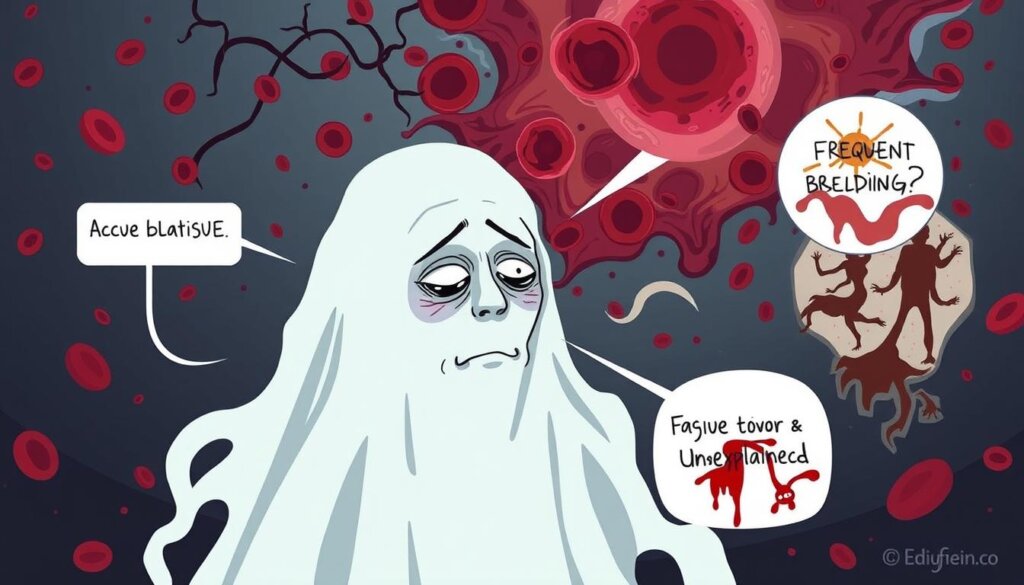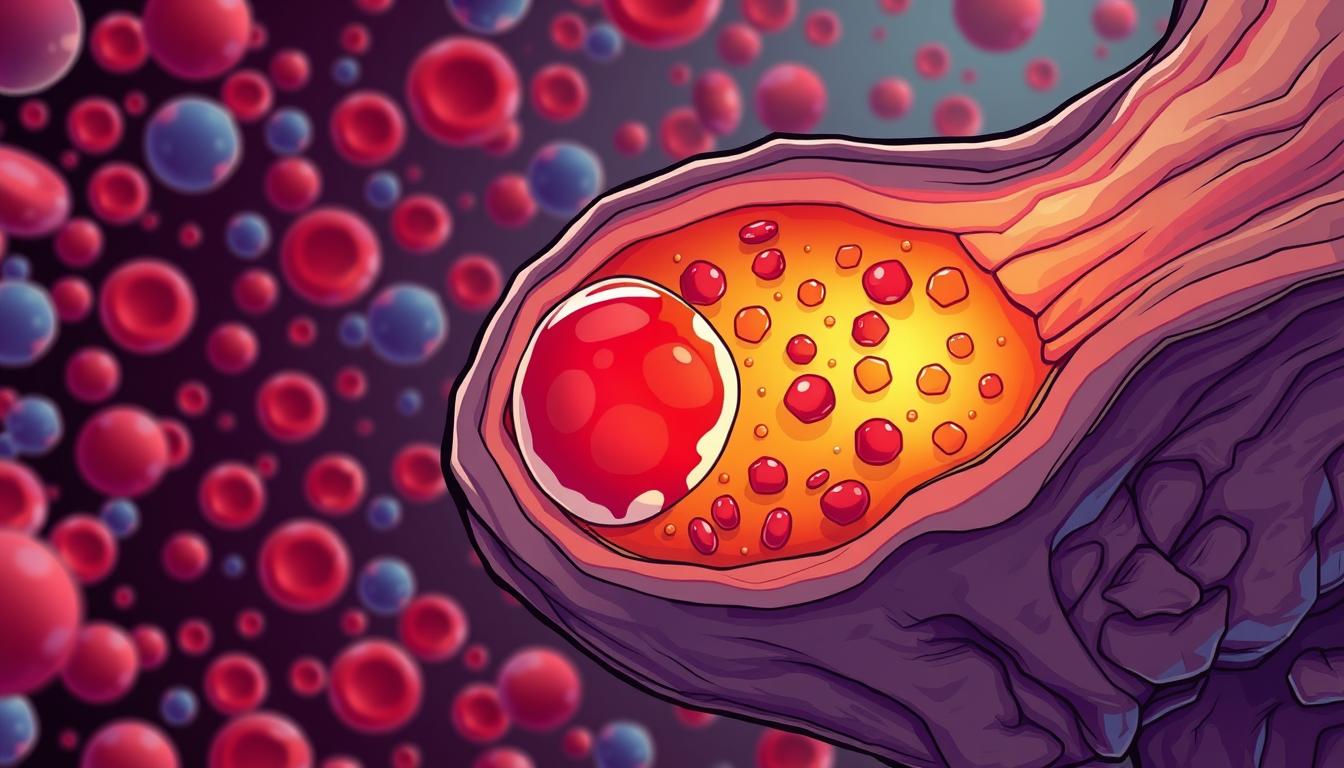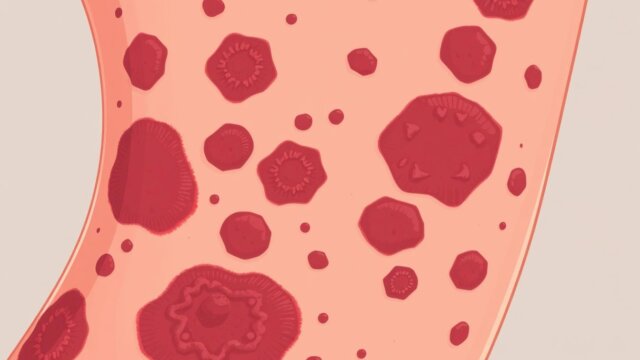FTC disclaimer: This post may contains affiliate links and we will be compensated if you click on a link and make a purchase.
Acute myeloid leukemia (AML) is a serious disease. It affects over 20,000 people in the United States each year. This blood cancer stops the body from making healthy blood cells. It gets worse fast and needs quick medical help.
AML starts in the bone marrow. It can spread to the blood and harm organs. This makes it hard for the body to fight off infections and carry oxygen.
- Acute myeloid leukemia (AML) is a rapidly progressing blood cancer that affects the production of healthy blood cells.
- AML is the most common type of acute leukemia in adults, with an annual incidence of approximately 4.3 new cases per 100,000 population.
- The median age at the time of AML diagnosis is around 68 years old, with a higher prevalence observed among non-Hispanic Whites.
- Genetic mutations, environmental factors, and underlying health conditions can increase the risk of developing AML.
- Prompt diagnosis and effective treatment are crucial for managing this aggressive form of blood cancer.
What is Acute Myeloblastic Leukemia?
Acute myeloblastic leukemia (AML) is a blood cancer that starts in the bone marrow. It affects how myeloid cells, a type of white blood cell, fight infections. AML causes too many immature cells, called myeloblasts, which means not enough healthy blood cells. This leads to many symptoms.
Types and Subtypes of AML
AML has many subtypes, each with different cell features. The most common is acute promyelocytic leukemia (APL). It has a special genetic change that stops promyelocytes from growing up right.
Acute Promyelocytic Leukemia (APL)
APL is a special kind of AML, making up about 10-15% of cases. It has a unique genetic problem that stops promyelocytes from growing up. This causes these cells to pile up in the bone marrow, blocking healthy blood cell making.
AML Subtype | Characteristics |
|---|---|
Acute Promyelocytic Leukemia (APL) |
|

Symptoms of Acute Myeloblastic Leukemia
Acute myeloblastic leukemia (AML) is a common leukemia in adults. It starts with symptoms like fever, fatigue, and feeling unwell. As it gets worse, you might notice easy bruising, frequent nosebleeds, and pale skin.
AML disrupts blood cell production. This is because of abnormal cells in the bone marrow and blood. These abnormal cells can cause many symptoms.
- Fever, shortness of breath, and weakness are common symptoms of AML.
- Easy bruising or bleeding and petechiae (tiny red spots on the skin) can also occur due to the low platelet count.
- Bone or joint pain may be experienced as a result of the accumulation of leukemia cells in the bone marrow.
AML is more common in men than in women. Younger people with AML have a better survival rate than older ones. If cancer doesn’t come back in 5 years, you’re likely cured.

It’s key to spot AML symptoms early. Quick diagnosis and treatment can greatly improve your chances. Visit Healthyious to learn more about leukemia symptoms.
Causes and Risk Factors
The exact causes of acute myeloblastic leukemia (AML) are not fully understood. But we know genetic mutations and environmental factors play a role. Genetic disorders like Down syndrome and Li-Fraumeni syndrome can raise the risk of AML.
Exposure to radiation and chemicals like benzene also increases the risk. Previous cancer treatments, such as chemotherapy, can also lead to AML.
Genetic Mutations and Disorders
Genetic mutations cause myeloid cells to grow uncontrollably, leading to AML. Inherited conditions like Down syndrome increase the risk of AML. These conditions disrupt normal cell growth, contributing to the disease.
Environmental Factors
Environmental exposures can also lead to AML. Radiation, from medical treatments or the environment, raises the risk. Chemicals like benzene, found in various products, also increase the risk.
Smoking, which exposes people to benzene and other harmful chemicals, is linked to AML.
Even without known risk factors, AML can still occur. Understanding these causes and risk factors is key to early detection and management.

Risk Factor | Description |
|---|---|
Age | The risk of AML increases with age, being most common in adults aged 65 and older. |
Gender | Men are more likely to develop AML than women. |
Previous Cancer Treatments | Individuals who have had certain types of chemotherapy and radiation therapy are at a greater risk of developing AML. |
Radiation Exposure | People exposed to high levels of radiation, such as survivors of nuclear accidents, have an increased risk of developing AML. |
Chemical Exposure | Exposure to chemicals like benzene is linked to a higher risk of AML. |
Smoking | Smoking, due to the presence of benzene and other cancer-causing chemicals, is associated with AML. |
Other Blood Disorders | Those who have had other blood disorders such as myelodysplasia, myelofibrosis, polycythemia vera, or thrombocythemia are at greater risk of developing AML. |
Genetic Disorders | Certain genetic disorders including Down syndrome are associated with an increased risk of AML. |
Diagnosing Acute Myeloblastic Leukemia
Diagnosing acute myeloblastic leukemia (AML) is a detailed process. It includes many tests and exams. These steps are key to finding out if you have AML and what kind it is. This helps doctors choose the right treatment.
Blood Tests
Blood tests are very important in the first steps of diagnosing AML. A complete blood count (CBC) and a blood smear check for abnormal cells. They also tell us about the different types of blood cells.
Other blood tests look for signs of other health issues. This could be liver or kidney problems, or issues with blood clotting.
Bone Marrow Tests
Bone marrow tests are key to confirming AML. Doctors use these tests to look at the bone marrow for cancer cells. For AML, doctors need to see at least 20% blasts in the bone marrow or blood. Normal bone marrow has 5% or fewer blasts.
Molecular and Genetic Testing
More tests, like flow cytometry and genetic analysis, help find specific genetic changes. These changes help doctors decide on the best treatment. Tests like FISH and PCR can spot small genetic changes not seen with the naked eye.

“Diagnosing acute myeloblastic leukemia is a critical first step in developing an effective treatment plan. The comprehensive evaluation, including blood tests, bone marrow examinations, and molecular analysis, provides valuable insights into the specific characteristics of the disease, ultimately guiding the most appropriate course of action.”
Acute Myeloblastic Leukemia Treatment Options
Treating acute myeloblastic leukemia (AML) often means using a mix of therapies. The main goal is to get you into remission, where no signs of the disease show up.
First, you’ll get induction chemotherapy. This aims to kill as many cancer cells as it can. Then, consolidation chemotherapy follows to kill more cells.
For some types of AML or if you’re at high risk, you might get targeted therapies or a stem cell transplant. These can help you stay in remission longer. Your treatment plan will depend on your age, health, AML type, and how you react to treatment.
- Chemotherapy is key in AML treatment. About 60% to 70% of adults with AML get complete remission after induction therapy.
- But, more than 25% of adults who get complete remission might live 3 or more years. This shows the need for more treatments to keep remission.
- Targeted therapies, like treatments for specific genetic mutations in leukemia cells, are promising for some AML types.
- Stem cell transplants, both autologous and allogeneic, can also be part of AML treatment. They’re especially useful for younger, healthier patients.
Talking to your healthcare provider about treatment options is very important. They can explain the benefits, risks, and side effects of each choice. Together, you can make a treatment plan that improves your chances of long-term remission and better quality of life.
Statistic | Value |
|---|---|
Estimated new cases of AML in the US (2024) | 20,800 |
Estimated deaths from AML in the US (2024) | 11,220 |
5-year survival rate for AML | 31.7% |
Median age at AML diagnosis | 69 years |
“Discussing treatment goals, clinical trial participation, and potential side effects with the healthcare provider is crucial.”
By knowing the different AML treatments, you can work with your healthcare team. Together, you can create a plan that meets your unique needs and aims for the best outcome.
Complications of Acute Myeloblastic Leukemia
Acute myeloblastic leukemia (AML) can cause serious problems because it messes up how blood cells are made. It can lead to anemia, which means not enough red blood cells. This makes people feel tired and weak. It also causes a low platelet count, leading to more bleeding and bruising.
AML also weakens the immune system. This is because there are fewer white blood cells to fight off infections. In some cases, the cancer can spread to the brain, causing neurological problems.
Treatment for AML can also cause problems. These include mouth ulcers, diarrhea, hair loss, and rashes. Patients might feel nauseous, tired, or have nerve damage. They might also lose their appetite.
Chemotherapy can affect fertility, so patients should talk to a fertility specialist before starting treatment. Long-term effects can include heart disease, infertility, and thyroid problems. There’s also a small chance of getting another cancer.
AML complications can be deadly if not treated right away. While death rates have gone down, older patients and those with certain risk factors still face higher risks. Problems like major bleeding and heart failure can lead to early death.
Complication | Prevalence | Impact |
|---|---|---|
Anemia | Common | Fatigue, weakness, pale skin |
Thrombocytopenia | Common | Increased bleeding and bruising |
Infections | Common | Fever, ongoing infections |
Central Nervous System Involvement | Rare | Headache, weakness, seizures, confusion |
Tumor Lysis Syndrome | Uncommon | Severe damage to kidneys and heart |
Differentiation Syndrome | Uncommon | Fever, limb swelling, breathing troubles |
AML can lead to many complications, from blood cell problems to serious issues with organs. Knowing about these complications and getting medical help quickly can help AML patients do better.
Acute Myeloblastic Leukemia and Life Expectancy
The outlook for people with acute myeloblastic leukemia (AML) can change a lot. It depends on several important things. In the United States, the 5-year survival rate for leukemia is 65%. But for AML, it’s much lower, at 31.7%.
Age is a big factor in AML’s outlook. Almost 60% of people under 40 can live 5 years or more after diagnosis. But for those 70-79, the 5-year survival rate is only about 5%. Genetic mutations and the disease’s stage at diagnosis also play a big role.
Age Group | 5-Year Survival Rate for AML |
|---|---|
Younger than 40 | Almost 60% |
40-49 | Almost 55% |
50-59 | Around 35% |
60-69 | More than 15% |
70-79 | Around 5% |
80 and over | Only 1% |
Even though AML’s outlook is tough, especially for older adults, progress in medicine has helped. This progress has improved some patients’ chances in recent years. Knowing what affects AML’s prognosis helps doctors and patients make better choices about treatment.
Coping with Acute Myeloblastic Leukemia
Getting a diagnosis of acute myeloblastic leukemia (AML) can be very stressful. Many feel shocked and unsure when they hear they have AML. It’s okay to feel many emotions and to ask for help from those who understand.
Support Groups
Being part of a support group, online or in person, can be very helpful. It lets you share your story and learn from others. It’s also important to stay organized and focused on your treatment.
Mental Health Care
Talking to mental health experts can help with feelings of anxiety and sadness. Getting clear information and support can make a big difference.
Cancer rehabilitation programs can help with physical and functional issues.
“Listening to your body and promptly reporting any changes or signs of infection to your medical team is crucial during the AML journey.”
It’s important to listen to your body and report any changes to your doctor.
Latest Research on Acute Myeloblastic Leukemia
The study on Acute Myeloblastic Leukemia (AML) is showing great progress. Scientists are looking into new ways to treat it. This includes targeted therapies, immunotherapy, and personalized medicine based on each patient’s cancer.
They are focusing on targeted therapies that attack specific genetic changes in AML. These treatments, when used with traditional chemotherapy, are helping some patients. They are also studying immunotherapy and stem cell transplants to make treatments better and increase survival chances.
Clinical trials are testing these new methods. The goal is to find better treatments and improve survival rates for AML patients. For instance, a trial at Memorial Sloan Kettering Cancer Center is using CAR T-cell therapy to target AML cells.
Scientists are also learning more about the genetic changes in AML. This knowledge helps in creating personalized medicine plans. These plans are tailored to each patient’s cancer.
The future of AML treatment looks bright. Researchers are working hard to make treatments better and improve life for those with this blood cancer.
Conclusion
Acute myeloblastic leukemia (AML) is a serious blood cancer that needs quick action. It’s the most common leukemia in adults, making up 80 percent of cases. In the U.S., over 20,000 people get it each year. Knowing about AML’s types, symptoms, and causes is key for treatment choices.
Even though AML is tough, especially for older adults, new treatments offer hope. Targeted therapies and personalized care have helped some patients. Genetic changes like FLT3-ITD and NPM1 help doctors plan better treatments.
More research and trials are needed to fight AML. Studies on genetic mutations and new treatments are promising. Keeping up with AML research helps doctors and patients work together for better care.
FAQ
What is Acute Myeloblastic Leukemia (AML)?
AML is a fast-growing cancer of blood cells. It happens when the bone marrow makes too many immature cells. This stops it from making healthy blood cells.
What are the different subtypes of AML?
AML has many subtypes based on cell maturity and type. The most common is acute promyelocytic leukemia (APL). It has a special genetic change that stops cells from growing right.
What are the symptoms of Acute Myeloblastic Leukemia?
Early signs of AML feel like the flu. You might feel tired, have fever, or just not feel well. Later, you might notice easy bruising, pale skin, or trouble breathing.
What causes Acute Myeloblastic Leukemia, and who is at risk?
AML is caused by genetic changes that let cells grow too much. Some people, like those with Down syndrome, are more likely to get it. Exposure to chemicals or radiation also raises the risk.
How is Acute Myeloblastic Leukemia diagnosed?
Doctors use blood tests and bone marrow exams to find AML. Blood tests look for abnormal cells. Bone marrow tests confirm the diagnosis by checking for cancer cells. More tests might be needed.
What are the treatment options for Acute Myeloblastic Leukemia?
AML treatment often includes chemotherapy and sometimes a stem cell transplant. The first step is to kill as many cancer cells as possible. Then, more treatment is used to keep the cancer away.
What are the potential complications of Acute Myeloblastic Leukemia?
AML can cause anemia, low platelets, and a weak immune system. This makes infections more likely. In some cases, cancer cells can get into the brain, causing problems.
What is the prognosis for individuals with Acute Myeloblastic Leukemia?
AML’s outlook varies. Younger people might live 30-40% longer than older adults. It depends on age, health, type of AML, and how well it responds to treatment.
How can patients cope with Acute Myeloblastic Leukemia?
Getting AML news is tough. It’s key to find emotional support and practical help. Joining a support group or talking to mental health experts can help. Cancer rehab programs can also help with physical and functional issues.
What are the latest advancements in Acute Myeloblastic Leukemia research?
AML research is moving forward. New treatments and ways to fight the disease are being tested. These include targeted therapies and personalized treatments. The goal is to improve survival and quality of life for those with AML.








